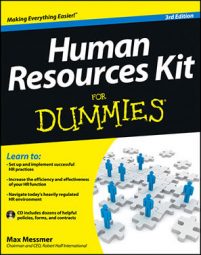Diversity in your company’s workforce includes a lot more than minority representation in your employee pool. Trends such as delayed retirement, second careers, and increased longevity mean that the age spread of workers is also greater today than ever before.
Diversity means that a wider range of people are bringing a greater variety of approaches, ideas, and lifestyle issues to the workplace. If, as they say, variety is the spice of life, then the workplace is getting more vibrant by the minute. To attract, retain, and maximize the contributions of all members of the changing workforce, HR policies must address these differences.
One example of how diversity is changing the way HR professionals function is the structure and administration of benefits packages. A one-size-fits-all plan is no longer commonplace. The trend today is toward cafeteria-style offerings, which give employees the opportunity to choose from a variety of benefits that best match their particular life and work circumstances.
To illustrate the value of cafeteria-style benefits, according to the U.S. Census Bureau, more people were 65 and over in 2010 than in any previous census. What’s more, between 2000 and 2010, this segment of the population increased at a faster rate (15.1 percent) than the population as a whole (9.7 percent).
With people living longer, an increasing number of employees are taking on the responsibility of caring for their aging parents or other relatives — a trend that’s introduced a new term to the employee benefits vocabulary: eldercare. And, as the number of working women with young children continues to climb, childcare assistance is another highly requested benefit.
The intergenerational workforce also requires a new way of thinking about staff management. Each generation has unique priorities, perspectives, skill sets, and work styles. Each tends to respond to different kinds of motivation, seeks different types of support from managers, and reacts in different ways to company programs and policies.
As Baby Boomers begin to retire, companies will inevitably face a loss of these experienced workers. You’ll need to ensure that your organization has a way to pass along their knowledge to the next generation of leaders. This responsibility carries profound implications for the kind of HR programs you build — from management skills training and flexible work arrangements to broader, strategic initiatives that help shape your firm’s overall culture.
Even after they officially retire, some Baby Boomers who have been focused on their careers for many years will ponder different directions. Highly skilled and experienced, they’re finding ready acceptance working as project professionals and consultants at companies that benefit from their expertise applied to critical initiatives.
But your goal in an HR role is not just to adapt to or react to these changes. You also should take advantage of the ways diversity can enhance creativity and productivity. Many companies today are discovering that, when you’re competing in the global marketplace, workforce diversity — especially at the managerial level — can be a significant competitive advantage.

